
Stretcher Bearers, World War One.
Today when someone is injured, our first instinct is to call 9-1-1. This is what we are trained to do from childhood -- let the experts handle it. But what if the "experts" aren't within calling distance? What if the only way we can can get someone injured -- or wounded -- from Point A to the medical care at Point B is to do it ourselves? They say that proper planning prevents poor performance. That works for casualty evacuation too.
There are a number of ways to hand carry a casualty from where he is wounded to where he can be put on a litter. Some of these basic carries are described here. An illustrated presentation is here. In the 90s, we practiced these at militia FTX's until we got them right.
However, the subject of this post is LITTER evacuation. One man, or even two, can manually carry a casualty only so far. The best way to transport wounded is by litter, also know as a stretcher. It is much easier on the casualty and on the folks assigned to carry him. On the litter, the casualty can be handed off from carrying party to vehicle to triage area to operating table without undue patient movement and stress.
Litter evacuation has been around a long time. Here is John Scott Riddell's 1897 classic A Manual of Ambulance, which still has lessons for today.
Here is modern basic run-down on litter evacuation from FM 8-10-6. Litters can be improvised, of course, and the manuals linked in this piece show you how to do so -- and you should learn how. (Above the tree line in mountains where there is little material to improvise a litter, you can even make a climbing rope litter.)

However, what I'd like to get you thinking about is some of the litters available today, civilian, military, and surplus, and how putting some of these back for "if, as and when" is not a bad idea.
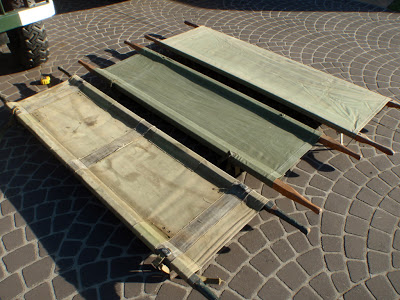 World War II "Furley" stretchers.
World War II "Furley" stretchers.Here is the standard collapsible litter of the Furley type used in every war of the 20th Century. You can still find these in surplus stores, and civilian equivalents just about everywhere. I have two in my inventory, with two more replacement canvases to go with them. When buying one of these, make sure the canvas is still stout, otherwise you risk a catastrophic failure at the worst possible time. You can replace a ripped canvas of course, by using a standard GI replacement canvas or even sewing your own improvisation, but it is a pain in the fingers as well as other body parts. Trust me, I did it once. Never again.
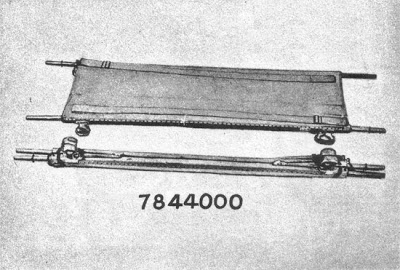
The principle problem with rigid pole stretchers is that even when the canvas is folded they are just so darn long and bulky. This led to the folding stretcher, which was first fielded by the U.S. Army in World War Two.
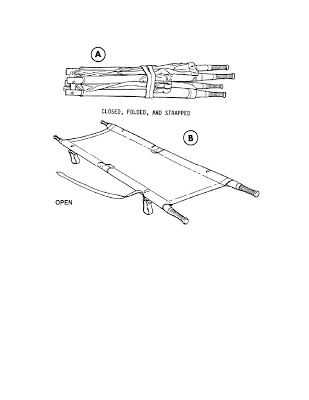
(For some stretcher history -- and some interesting ideas -- see WW2 US Army Litters, which includes images and descriptions of wheeled stretcher carts for carrying wounded long distances by hand and this drawing of a jeep-mounted litter frame.)
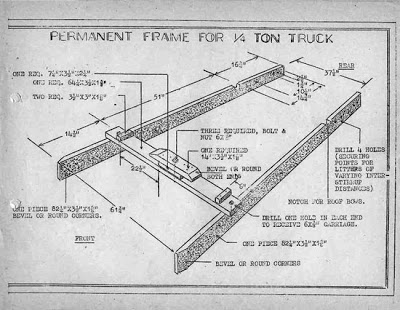
The U.S. Army also experimented with aluminum poles in World War II, which are less likely to snap under load than wood poles but more inclined to bend. Stretchers were also used to carry supplies -- ammo, water, rations -- up to the front line, so they could be easily over-stressed.
The pole-less semi-rigid litter was also fielded in World War II for use by mountain troops, allowing a casualty to be either carried or eased down by use of ropes.

Variations of this are still used and can be found in surplus stores and civilian outlets.
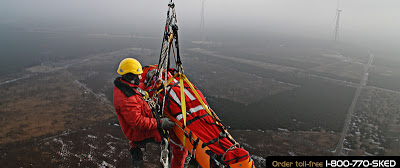 SKEDCO in action.
SKEDCO in action.A modern permutation of this in the Skedco.
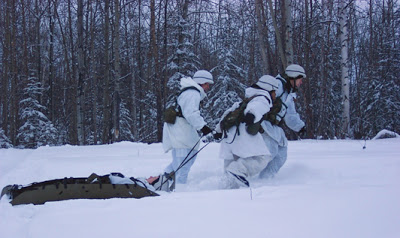
The Skedco is pretty much ubiquitous these days in civilian and military medical circles. You can move a casualty by rope, by dragging in the snow as above, or carried by the handles as in this image from Afghanistan.
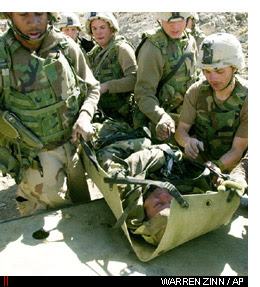
Here is an illustrated manual which covers how to deploy both the Skedco and the new North American Rescue Talon II 90C tactical combat stretcher, which is the ne plus ultra of military litters.

Originally designed with the U.S. Special Forces Operations in mind, the Talon II 90C is now in use Army-wide, as well as the U.S. Marines. It has retractable, ergonomically designed handles allowing casualty transport in restricted spaces, automatic locking hinges and a slip-resistant, chemical-resistant rip-stop fabric mesh that is far superior to the old canvas. It has 6 IV-attachment points and two integral patient-securing straps. This North American Rescue manual has instructions on how to deploy and maintain the Talon II on pages 18-23.
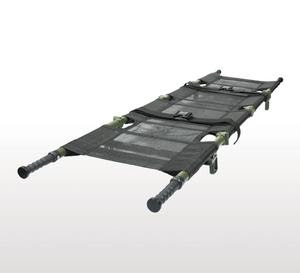
Folded up with the handles collapsed it is only 20.5 inches high, 8.5 inches wide, and 9.5 inches deep. The Talon II weighs only 16 lb 6 oz (7.4 kg) and has a payload of 1200 lb (544.3 kg)!
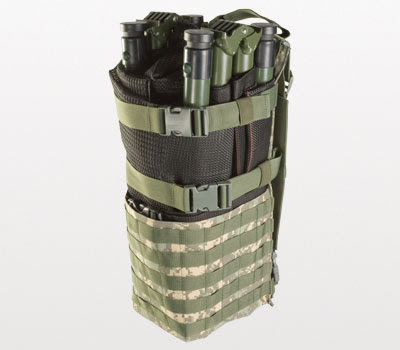
Talon II 90C in pack, ready to carry.
It is also increasing in civilian use as well as FEMA and other state and local emergency management agencies. Retailing new for around $600, it is expensive as hell, but I have seen examples in used but excellent condition sell at gun shows and flea markets for under a hundred bucks -- an outstanding value.
Anyway, there is enough here to start Threepers thinking about what sort of preps need to be made for the "if, as and when" of their own casualty evacuation. For no conflict comes without casualties.
5 comments:
And casualty evac has gone from a two soldier (guy GIs) to a four service member (girl GIs) task.
Take a look at the travois too. https://secure.wikimedia.org/wikipedia/en/wiki/Travois
Simple and effective, and can be constructed out of materials found at the site of need rather than carried around.
I love your blog; especially post such has these that benefit the Patriot on a tactical level. When I read this post I was reminded of a couple of excellent books by James C. Donahue. I believe they have been re released under the new titles of Blackjack-33 & Blackjack-34. Donahue was a Special Forces NCO assigned to the Mobile Guerrilla Force; which was basically a company sized unit of Cambodian soldiers lead by a SF team that went into VC controlled areas in an attempt to “out guerrilla the guerrillas.” Since they were moving light and not digging in like line infantry, he mentions in one of the books that they carried hammocks to sleep in and keep them off the jungle floor. Later in the book after a firefight when they had a wounded trooper they cut a long sapling down and tied his hammock to it and used it as an improvised liter. Depending on what region you are operating in this might make an excellent field improvised litter.
The Skedco in the snow brings back memories.
Pulling anything through knee deep snow with a sense of urgency will smoke you, and right now.
AP
A GI issue poncho may also be used as a field expedient stretcher I am assuming that 550 chord can be put thru the grommets so that multiple peope can carry the weight...seems like I saw a class on it in the Army, but cannot remember exactly how to do it without having a deep, wide contraption...anyone remember how to do it? I remember how to make a poncho raft, but not this. Am I remembering wrong about the/a "poncho litter"?
Post a Comment